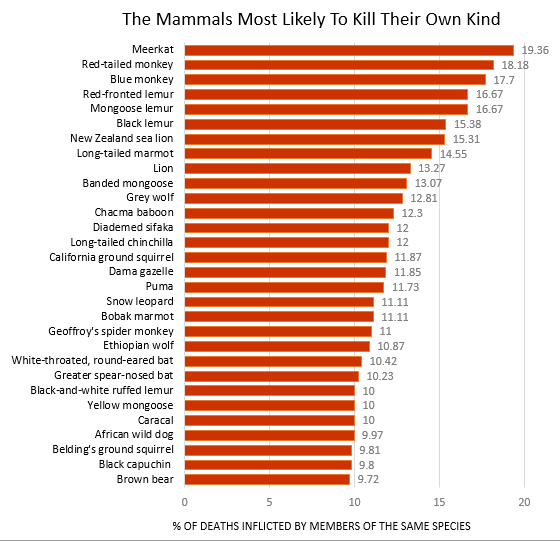As reported in The Atlantic,
Which mammal is most likely to be murdered by its own kind? It’s certainly not humans—not even close. Nor is it a top predator like the grey wolf or lion, although those at least are #11 and #9 in the league table of murdery mammals. No, according to a study led by José María Gómez from the University of Granada, the top spot goes to… the meerkat. These endearing black-masked creatures might be famous for their cooperative ways, but they kill each other at a rate that makes man’s inhumanity to man look meek. Almost one in five meerkats, mostly youngsters, lose their lives at the paws and jaws of their peers.
Gómez’s study is the first thorough survey of violence in the mammal world, collating data on more than a thousand species. It clearly shows that we humans are not alone in our capacity to kill each other. Our closest relatives, the chimpanzees, have been known to wage brutal war, but even apparently peaceful creatures take each other’s lives. When ranked according to their rates of lethal violence, ground squirrels, wild horses, gazelle, and deer all feature in the top 50. So do long-tailed chinchillas, which kill each other more frequently than tigers and bears do.
The article continues:
The point of this macabre census was to understand the origins of our own behavior. Gómez typically studies plants and insects, but he realized that the techniques he uses to study their evolution can be used to study our own. In particular, he noted that closely related species tend to show similar levels of lethal interpersonal violence. He could use those similarities to predict how violent any given mammal should be, and whether it meets, exceeds, or defies those expectations.
It turns out that humans “were six times more lethally violent than the average mammal, but about as violent as expected for a primate. But time and social organizations have sated our ancestral bloodthirst, leaving us with modern rates of lethal violence that are well below the prehistoric baseline. We are an average member of an especially violent group of mammals, and we’ve managed to curb our ancestry.”
By how much though? After “poring through statistical yearbooks, archaeological sites, and more,” the researchers were able “to work out causes of death in 600 human populations between 50,000 BC to the present day. They concluded that rates of lethal violence originally ranged from 3.4 to 3.9 percent during Paleolithic times, making us only slightly more violent than you’d expect for a primate of our evolutionary past. That rate rose to around 12 percent during the bloody Medieval period, before falling again over the last few centuries to levels even lower than our prehistoric past.”
The reason? Organization.
[O]nce we formed large states, “institutions like the rule of law reduced rates of lethal violence below what one would expect for a mammal with our ancestry and ecology, and below what has been observed in human societies in earlier periods and with simpler forms of social organization,” says Steven Pinker from Harvard University. He argued as much in his book The Better Angels of Our Nature, but says that Gómez’s team have done so “with greater precision, rigor, and depth; I wish this study had been available when I wrote the book.”
